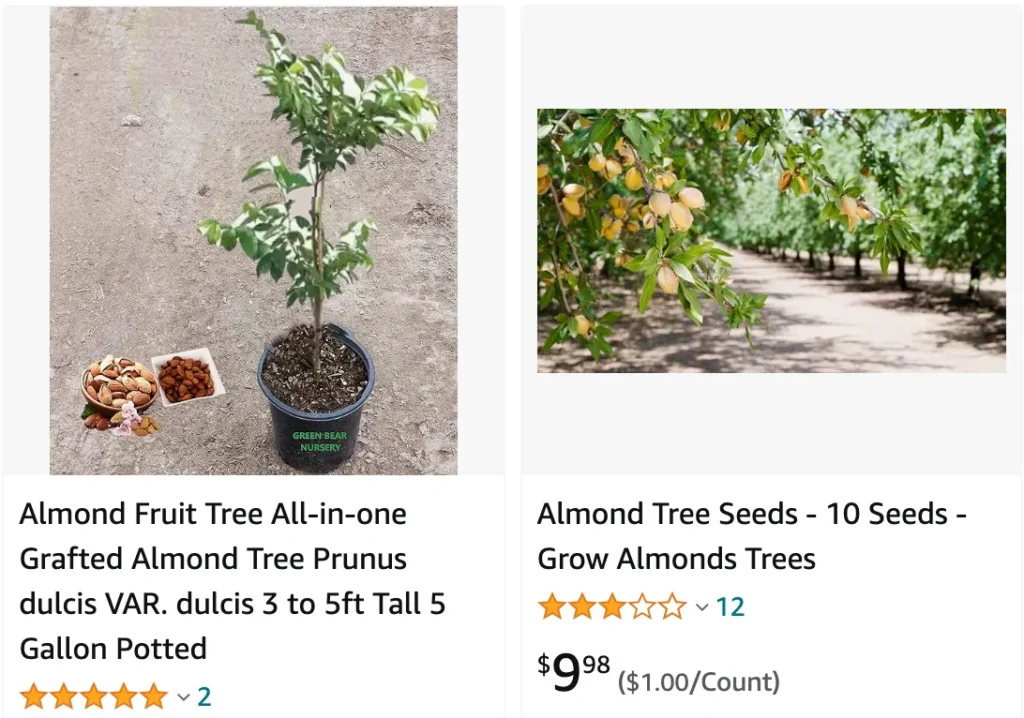
All About Almond Trees: A FAQ for Curious Gardeners
The allure of the almond tree is undeniable. Its delicate pink blossoms herald the arrival of spring, and the bounty of almonds it produces is a delicious and versatile treat. But beyond the beauty and the nuts, there’s a whole world of information about this fascinating tree. As someone who’s always curious about plants, I decided to delve into the world of almond trees and answer all the burning questions you might have.
390 Species in Genus Prunus
What is an Almond Tree Like?
Almond trees are a member of the rose family (Rosaceae), closely related to peaches, plums, and cherries. They’re deciduous, meaning they lose their leaves in fall, and can grow up to 30 feet tall. The most captivating feature of the almond tree is undoubtedly its springtime display. Masses of pale pink, five-petaled flowers adorn the bare branches, creating a breathtaking spectacle. These blossoms are not just beautiful; they’re also crucial for attracting pollinators, like bees, which are essential for nut production. Later in the season, the flowers give way to fuzzy green hulls that eventually house the almonds we know and love.
How to Care for an Almond Tree?
While almond trees are relatively low-maintenance, they do have specific needs to thrive. Here’s a quick rundown:
- Sunshine is Key: Almond trees are sun-worshippers. They need at least 6-8 hours of direct sunlight daily for optimal growth and nut production.
- Climate Matters: These Mediterranean natives prefer warm, dry summers and mild winters with occasional chills. They’re not big fans of frost, so consider your local climate before planting.
- Well-Drained Soil is a Must: Almonds dislike wet feet. Ensure your soil is well-draining and sandy or loamy to prevent root rot.
- Bee Buddies are Essential: Almond trees are not self-pollinating, so you’ll need at least two different varieties planted within close proximity to ensure good nut production.
- Water Wisely: Established almond trees are fairly drought-tolerant. Young trees, however, need regular watering during their first few years.
How to Propagate an Almond Tree?
Propagating an almond tree from seed is possible, but it’s not the most reliable method. Seedlings may not bear the same qualities as the parent tree, and they can take several years before producing nuts. A much better option is to purchase a grafted sapling from a reputable nursery. Grafted trees are guaranteed to produce the desired variety and will start bearing nuts much sooner, typically within 3-4 years.
What to Plant with Almond Trees?
Since almond trees require good air circulation for pollination, planting companion crops that complement their needs can be beneficial. Herbs like lavender and rosemary thrive in similar conditions and attract beneficial insects. Low-growing vegetables like lettuce or spinach can also be good companions, as long as they don’t compete for sunlight or nutrients.
Is Almond Milk Low FODMAP?
FODMAP stands for Fermentable Oligosaccharides, Saccharides, Monosaccharides, and Polyols – a group of short-chain carbohydrates that can be difficult for some people to digest and can cause digestive issues like bloating and gas. Almond milk is generally considered low-FODMAP, making it a good option for those following a low-FODMAP diet. However, it’s important to check the label for any added ingredients, such as inulin or chicory root fiber, which are high-FODMAP prebiotics.
Can Almond Milk Be Frozen?
Yes, almond milk can be frozen! This is a great way to extend its shelf life, especially if you don’t think you’ll use it all before the expiration date. However, keep in mind that freezing can alter the texture slightly. Once thawed, the almond milk may be a bit grainy, but it’s still perfectly safe to consume. Shake well before using to redistribute any separation.
Can dogs have almond butter?
While almond butter itself isn’t usually toxic to dogs, it’s not recommended for several reasons:
- High Fat: Almond butter is very high in fat, which can be hard on a dog’s digestion and could lead to pancreatitis, a painful inflammation of the pancreas.
- Sugar and Additives: Many commercial almond butters contain added sugar or artificial sweeteners like xylitol. Xylitol is extremely toxic to dogs.
- Choking Hazard: Thick, sticky almond butter can be a choking risk for some dogs.
What if my dog accidentally ate a bit of almond butter?
A tiny taste of plain, unsweetened almond butter is unlikely to harm a healthy dog. Keep an eye out for digestive upset (vomiting, diarrhea) and contact your vet if anything seems worrisome.
Can cats drink almond milk?
While a small amount of plain, unsweetened almond milk is unlikely to be immediately toxic to cats, it’s not recommended for several reasons:
- Digestive Upset: Cats are lactose intolerant, and although almond milk doesn’t contain lactose, the fats and sugars can still cause stomach issues like diarrhea and vomiting.
- Nutritional Imbalance: Cats are obligate carnivores, meaning their bodies are designed to get nutrition from meat. Almond milk provides no beneficial nutrients for them.
- Additives: Many commercial almond milks contain sweeteners, flavorings, or thickeners that could be harmful to cats.
What is almond bark?
Almond bark is a type of candy coating often used for dipping, drizzling, and molding. Here’s what makes it different from regular chocolate:
- Ingredients: Almond bark doesn’t contain any cocoa butter, the key ingredient in chocolate. Instead, it’s made primarily from vegetable fats, sugar, flavorings, and coloring.
- Taste: While often flavored to resemble chocolate, almond bark generally lacks the depth and complexity of real chocolate. It tends to be much sweeter.
- Texture: Almond bark melts and sets differently than chocolate. It doesn’t require tempering and gives a slightly softer, sometimes waxier finish.
- Uses: Almond bark is commonly found in grocery stores around the holidays, as it’s an easy and convenient way to make dipped pretzels, candy clusters, and other simple treats.
Does almond flour go bad?
Yes, almond flour can go bad. Here’s why:
- High-Fat Content: Almonds are naturally high in oils. These oils become rancid over time, even when ground into flour. This rancidity can give the flour a bitter, off-putting flavor.
- Shelf Life: Almond flour is more perishable than all-purpose flour. Here’s the general breakdown:
- Pantry: Unopened almond flour can last up to a year. Once opened, it’s usually best within 3-6 months for optimal freshness.
- Refrigerator: Storing almond flour in the fridge extends its shelf life to about a year.
- Freezer: Almond flour freezes well for up to a year or longer.
Signs of Spoiled Almond Flour
- Smell: Rancid almond flour will have a sour, slightly unpleasant odor.
- Taste: Take a tiny taste, if it’s bitter, it’s past its prime.
- Texture: Clumping, hardening, or signs of moisture indicate it might be going bad.
- Mold: Any sign of mold means you should immediately discard the flour.
Tips for Storing Almond Flour
- Airtight Container: This keeps moisture and pests out.
- Cool, Dark Place: A pantry is fine if used quickly; otherwise choose the fridge or freezer.
- Label with Date: This helps track how long it has been stored.
Does almond milk need refrigerated?
Absolutely! Here’s why almond milk needs to be refrigerated:
- Shelf-Stable vs. Refrigerated: You might find two kinds of almond milk in stores:
- Shelf-stable almond milk: This kind comes in aseptic cartons or boxes and can be stored unopened at room temperature. Once opened, it MUST be refrigerated and used within 7-10 days.
- Refrigerated almond milk: This is usually found in the refrigerated section of the store. It needs to be kept cold at all times, both before and after opening.
- Preventing Spoilage: Like all milk types, almond milk contains ingredients that spoil easily when left at room temperature. Bacteria can grow rapidly, making the milk unsafe to drink.
- Preservatives: Shelf-stable almond milk undergoes more processing and often contains additives to increase its shelf life. Refrigerated almond milk tends to be more natural with fewer preservatives.
Always check the label of your almond milk for specific storage instructions. If it was kept in the refrigerated section, keep it chilled both before and after opening.
- Almonds: While almonds themselves are only low FODMAP in tiny servings, almond milk is highly concentrated. This translates to a higher FODMAP content.
- Additives: Some commercial almond milk brands contain carrageenan or sweeteners like agave syrup, both of which are high FODMAP.
- Serving Size: According to Monash University, the maximum low FODMAP serving size for almond milk is 1 cup (250ml). More than that could trigger symptoms in sensitive individuals.
How to make almond extract?
Homemade almond extract is surprisingly easy to make and the flavor is far superior to store-bought! Here’s how to do it:
Ingredients:
- Raw Almonds: About 1/3 to 1/2 cup of whole, unroasted almonds for a standard-sized bottle of extract. You can adjust this depending on how strong you want the flavor.
- Vodka (or other alcohol): An 80-proof vodka is typical, but you can also use brandy, bourbon, or rum. You’ll need enough to cover the almonds completely.
- Small Glass Jar with Lid: Make sure it’s thoroughly cleaned and sterilized.
Instructions:
- Blanch and Chop:
- Briefly boil the almonds to loosen the skins. Slip the skins off and let them dry.
- Roughly chop the almonds. This increases surface area, helping the flavor infuse.
- Combine: Place the almonds into your jar and pour in the alcohol, aiming to cover the almonds by at least an inch. Seal the jar tightly.
- Steep: Store the jar in a cool, dark place for at least 2 months. The longer it steeps, the stronger the flavor. Shake the jar occasionally.
- Strain: When ready, strain the mixture through cheesecloth or a fine-mesh strainer to remove almond solids.
- Store: Pour the strained extract into a clean, sterilized amber glass bottle for longer shelf life. Store in a cool, dark place. Your homemade almond extract should last for several years.
Tips:
- Quality Matters: Use the freshest almonds and good quality alcohol for the best results.
- Flavor Variation: Add a split vanilla bean to the jar for a hint of vanilla alongside the almond flavor.
- Gift Idea: Homemade extract makes a lovely, thoughtful gift!
What does an almond tree look like?
Almond trees have a few distinct characteristics that help you identify them:
- Shape: Mature almond trees have a rounded, spreading canopy with graceful, slightly arching branches.
- Leaves: Almond leaves are long, narrow, and lance-shaped with serrated edges. They have a bright green color that turns a lovely yellow-orange in the fall.
- Flowers: In the early spring, before the leaves fully emerge, almond trees burst into a stunning display of pale pink or white blossoms. They have five petals and resemble cherry or peach blossoms.
- Fruit: After the flowers fade, the almonds themselves start to develop. They start out as fuzzy green pods that gradually harden and turn brown. Inside is the pit that holds the edible almond kernel we all know and love.
- Bark: The bark on an almond tree is smooth and grayish when young, becoming rougher and developing furrows as the tree ages.
Does almond milk make you constipated?
While almond milk itself doesn’t usually cause constipation, there are a few ways it could contribute to the issue in some individuals:
- Lack of Fiber: Unlike whole almonds, almond milk has very little fiber. Fiber is crucial for healthy digestion and regular bowel movements. If you have a generally low fiber diet, switching to almond milk could make things worse.
- Intolerance: Some people have sensitivities to components in almond milk, whether it’s almonds themselves or additives like carrageenan. This sensitivity could lead to digestive issues, including constipation.
- Replacing High-Fiber Sources: If you switch from cow’s milk to almond milk and don’t compensate with other fiber-rich foods, your overall fiber intake decreases, potentially causing constipation.
For most people, almond milk is a neutral beverage that shouldn’t cause constipation on its own.
Here’s what to do if you think almond milk might be a factor:
- Increase Fiber: Make sure to eat plenty of fruits, vegetables, and whole grains throughout the day.
- Stay Hydrated: Drinking lots of water aids digestion and helps prevent constipation.
- Experiment: Switch to a different plant-based milk alternative if almond milk continues to cause issues.
- Talk to Your Doctor: If constipation is persistent or concerning, consult a doctor to rule out any underlying medical causes.
Almond tree vs Cherry blossom
Almond trees bring a serene beauty with their delicate blossoms, but cherry blossoms captivate with their ethereal pink clouds that transform any landscape.
Almond tree vs Peach tree
While almond trees offer delicate blooms early in the spring, peach trees bring a burst of juicy sweetness that makes summer mornings a delight.
Pistachio tree vs Almond tree
Growing almond and pistachio trees side by side, the almond tree’s blossoms are subtle, whereas the pistachio tree’s greenish blooms add a unique charm to the orchard.
Almond tree vs Apricot tree
The almond tree’s flowers are more delicate compared to the robust blooms of the apricot tree, each announcing the arrival of spring in its own vibrant way.
Almond tree vs Olive tree
Almond trees provide a reliable harvest of nutritious nuts, while olive trees offer fruit that transforms into golden oil, each representing the bounty of the Mediterranean landscape.
By now, you’ve hopefully gained a deeper appreciation for the fascinating almond tree and the delicious treats it produces. From caring for these springtime beauties to understanding the best way to use their bounty, this FAQ has hopefully satiated your curiosity. Remember, gardening is a journey of learning and experimentation. So, if you’re thinking about planting an almond tree, don’t be afraid to get your hands dirty and enjoy the process!


